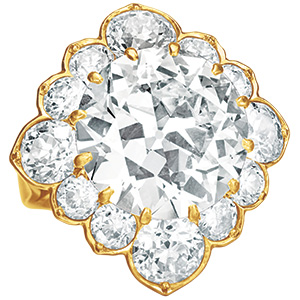|
Auctions
Super Selective
Christie’s New York sale of Magnificent Jewels pulled in a solid total, although buyers were especially choosy.
By Amber Michelle

|
| From the estate of the Honorable Noreen Stonor Drexel, the ring, signed Webb for David Webb, features a 12.55-carat Old European cut diamond that had belonged to Mr. Drexel’s grandmother. The ring sold for $881,000. The setting was a collaboration between Mr. Drexel and Webb, circa early 1970s. |
Chaos ruled in Washington, D.C., as Congress debated on whether or not to reopen the U.S. government and raise the debt ceiling, keeping the nation and the world on tenterhooks. It was amid this uncertain scenario that Christie’s New York held its fall sale of Magnificent Jewels on October 15. Despite what appeared to be a very quiet auction, the sale tallied up a very respectable $46,675,125, against a presale estimate of $40 million. The 389-lot sale was 75 percent sold by lot and 84 percent sold by value. This total compares to the October 2012 sale that pulled in $49,993,175 and the April 2013 auction that garnered $81,358,700.
The top lot of the sale was an 8.77-carat, rectangular-shaped fancy intense pink VVS1 diamond that was sold to Moussaieff Jewellers for $6,325,000* during a long-drawn-out bidding session. In another long bidding battle, a 3.81-carat rectangular-shaped fancy vivid blue VS1 diamond sold to an anonymous buyer for $3,973,000. “The market remains strong, especially at the top end,” comments Rahul Kadakia, head of jewelry, Christie’s Americas and Switzerland.
There were a number of yellow diamonds in the sale that did not find homes and Kadakia notes that yellows are the one soft area in the market. “Top intense and vivid diamonds are doing very well, but regular goods are not faring quite as well.”
The mood in the room was subdued and while there was a trade presence, many of the regulars who come to the auctions were not present. The usual buzz of anticipation and dealer chatter that generally happens in the back of the room was notably missing from the general ambience. A bright spot in the room came from an Asian bidder — presumably buying for others — who bought up a few lots and immediately disappeared when the action was over. Otherwise, most of the bidding, as usual, was over the phone, with some online activity. With a few exceptions, there was very little competitive bidding and a number of pieces sold below estimate. “There were lots sold without reserve and in some cases, the reserves were lower than the estimates,” explains Kadakia.
With no big rock headlining the auction, this was a much more subdued sale than usual and buyers were ultra-selective in their purchases. Two fabulous estates from society doyennes were highlights of the day. One estate was from San Francisco native Diana Dollar Knowles, who was at one time married to Joseph Hickingbotham, the chairman of the board of Shreve & Co., one of the most respected jewelry stores in the U.S. The other estate was from the Honorable Noreen Stonor Drexel, of Newport, Rhode Island. The daughter of a titled British family, Noreen was brought to the U.S. for safety on the eve of World War II. She met and married John Drexel III, a member of the prominent banking family and descendant of the founder of Drexel University.
Both women were known for their philanthropy, impeccable good taste and fabulous jewels. One thing both had in common in their jewelry collections were numerous pieces of vintage David Webb jewelry from the 1960s and 1970s, a point in time when the designer was at his prime. In what was an otherwise staid sale, these estates — particularly the Webb
pieces — churned up some excitement as bidders vied vigorously for the opportunity to own a David Webb collectible. “These were beautiful jewels from the 1960s that appeared on the market for the first time since they were purchased and collectors responded very strongly,” says Kadakia.
Colored gems fared better than usual at this sale with emeralds taking center stage and selling strongly. There were a large number of emerald pieces in the sale and those jewels sold well. “Between polished stones and beads, all of the emeralds were of fine quality and important sizes,” notes Kadakia. “Supply from Colombia is also not quite the same, which helped prices, too.”
Concluding the sale, and back for round two at the auction, was the Van Cleef & Arpels Argentine Flag brooch. This historic sapphire, yellow and white diamond brooch once belonged to Eva Perón. The brooch had been on the block at Christie’s in April of 1998, shortly after the movie “Evita” came out starring Madonna. During that sale, excitement in the room reached a fever pitch as Argentinean television star Susana Gimenez, followed by a film crew, bid ferociously for the brooch. Estimated between $80,000 and $120,000, the price soared until Gimenez threw down the paddle and dropped out of the bidding. The prize ultimately went to a private American collector of historical objects who paid $992,500 for the brooch. According to a source close to the auction, in all the years the collector owned the brooch, his wife never wore it so he decided to sell it. This time the brooch was estimated at $300,000 to $500,000. It sold to an Argentinean collector for $461,000.
This sale proved the auction rule once again: The hard to find, unusual, fine gems and signed jewels will always sell for a strong price regardless of the world economic climate.
*All prices include buyer’s premium.Article from the Rapaport Magazine - November 2013. To subscribe click here.
|
|